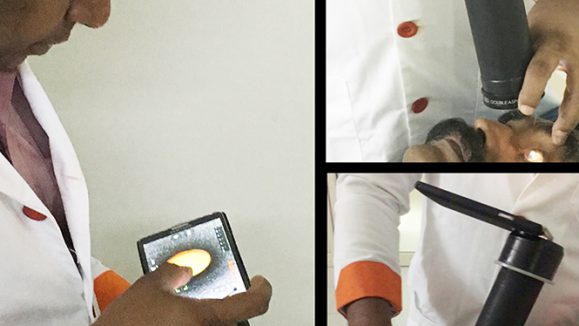British Prime Minister Boris Johson remains in the hospital, the global death toll continues to climb, equipment shortages persist . . . and it seems that the coronavirus is not going anywhere.
While progress is being made, it comes incrementally, which forces ophthalmologists to continue to struggle and adapt without sacrificing on patient care or safety. Medical innovation is difficult enough to achieve under safe and regular circumstances — so, how can we improve under this new grim reality?
Telemedicine to the Rescue

The disruption to ophthalmology is most evident in the mass cancellations of routine treatments. Most clinics and hospitals have significantly scaled back surgical procedures and are only continuing with emergency operations. The effect on clinical efficacy, as well as patients’ well being, is considerable.
Telemedicine is now emerging as a stop-gap measure for clinicians. The technology has been around for decades, but it has seen underwhelming utilization in ophthalmology and other medical sectors.
However, the coronavirus has forced the medical industry to frantically search for new methods to mitigate disruptions caused by the pandemic. Private health insurance companies, primarily in the United States, have dragged their heels on adopting telemedicine for years, though now the pandemic is forcing a change.
Far-sighted Studies in 2019

It is prescient that several studies were conducted into the efficacy of telemedicine in ophthalmology just last year.
Scientists from the Ludwig Maximilian University of Munich, Moorfield Eye Hospital in Croydon, London, and a number of other European institutes conducted a study on using cloud-based referral platforms to improve communication between optometrists and ophthalmologists. The study took place at Moorfields Eye Hospital. Over 10 months, 107 patients were seen by 11 optometrists.
The researchers found that 54% of the patients studied did not require further referral which would have been ordered under normal clinical procedures.1 They concluded that the uptake of cloud software telemedicine would alleviate considerable pressure on health services by freeing up doctors to attend to more serious or urgent cases.
According to the U.K.’s Royal College of Ophthalmology, demand for telemedicine — particularly in the treatment of diabetic retinopathy — was vastly outstripped by demand even before coronavirus hit. The success of pilot virtual clinics covering a wide array of subspecialties, including medical retina, glaucoma and urgent care ophthalmology, has not been replicated on a national level.2 This is explained by a lack of access to data, commissioning services lacking the ability to drive change, and the lack of infrastructure and leadership culture required to support change.
Cometh the Crisis, Cometh the Catalyst
The coronavirus is doing an excellent job of exposing these shortcomings. Access to telemedicine is now a priority for most healthcare systems, including ophthalmology.
Generally, only emergency ophthalmic surgery is continuing. What constitutes an emergency can vary by clinic and country. However, major procedures like cataract surgeries are not going ahead.
Telemedicine cannot replace surgery — but it is making primary care safer and more efficient. According to Dr. Kendrick Co Shih at the University of Hong Kong, telemedicine is a crucial and effective means to continue both treatment and education during the pandemic.
“Due to the limitations posed by the COVID-19 pandemic we have come up with a way to teach and reinforce clinical skills training by creating an e-learning website for students, and we hope to go further,” said Dr Shih.
He added that treatment for serious chronic conditions like diabetic retinopathy is able to continue thanks to telemedicine and that ophthalmologists are now being enabled to create improved triage systems.
An Overdue Opportunity for Ophthalmology
The pandemic is emphasizing telemedicine’s efficacy — and it’s about time. Its use in education is well established, but further implementation in medical practice is long overdue.
Uptake has historically been hampered by outdated legislation and aversion to new technology. In the U.S., 21 states and territories still do not allow the practice of medicine across state lines, constituting an effective ban on telemedicine. Most insurers still either have significant copays on telemedicine, or don’t cover it altogether.
This is beginning to change in response to the coronavirus. The Commonwealth of Massachusetts now requires all health providers to cover telemedicine, other states are due to follow suit, and the insurance companies United Healthcare, Humana and Aetna all now provide telemedicine services. This sets a precedent for the health insurance industry.
The American Federal Communications Commission (FCC) released funding of $200 million in March to support a telemedicine provision. Acceptance is clearly growing however telemedicine faces significant hurdles before wider implementation. Security issues persist and uptake of new technology is limited — and new developments are required.
AI is on the Way
AI (artificial intelligence) technology will likely represent the next stage of telemedicine expansion in ophthalmology. At present, AI is limited to chatbots acting as self-administered triage facilities. As self-administration increases exponentially during the pandemic, an opportunity is arising to significantly improve AI-based telemedicine with user experience and big data.
According to Dr. Shih, deep learning systems based on AI are already commercially viable and the virus is teeing up the next wave of telemedicine expansion post-pandemic.
“The next development state will be to use deep learning systems in assisting clinician decision making, for example, in laser refractive surgery and cataract surgery,” said Dr. Shih.
Every Cloud has a Silver Lining

Reduced face-to-face interactions with patients is not likely to reduce patient satisfaction as telemedicine offers a number of advantages that will improve their overall experience. These include faster diagnoses, reduced waiting times and improved ease of access.
All crises create opportunity and coronavirus is no different. Disruption to treatment will be considerable, but telemedicine, in the long run, will make many ophthalmological procedures more convenient and even safer.
Nothing will replace the quality or necessity of in-person eye exams but telemedicine is here to stay — and ophthalmology stands to benefit from its widespread implementation.
References
- Kern C, Fu Dun J, Kortuem K, et al. Implementation of a Cloud-Based Referral Platform in Ophthalmology: Making Telemedicine Services a Reality in Eye Care. Br J Ophthalmol. 2020;104(3):312-317.
- Islam M, Kern C, Sim DA. Telemedicine. FOCUS — The Royal College of Ophthalmologists Quarterly Magazine. April 2019.





thanks for the information